
The overweight cat is becoming a problem, as overweight and obese cats now outnumber cats of normal weight. Because of these extra pounds, the cat can be predisposed to diabetes, hepatic lipidosis (fatty liver disease,) and arthritis. In 2011, a study by APOP (Association for pet obesity prevention) found over 50% of cats to be either obese or overweight.
There is a simple reason. Any individual mammal, including humans, will gain body weight if he consumes more calories than he burns as fuel or energy. Simply put, he is eating too much. So how do you put your cat on a diet?
When in the wild, an animal has to work for its food. In order to acquire something to eat, it was necessary to put forth some physical exertion.
Not so in the current day and age. Everything we need can be purchased at a nearby store. We have learned how to create surplus food supplies that can be stored until needed.
We raise animals for food or grow vegetables and fruits that can be preserved. We can refrigerate, dry, store and preserve foods in large quantities. Now we don’t have to go out on a hunt, and we can last for long periods of time by living on stored foods.
Now we no longer have to live outdoors if we choose not to do so. Now both us and our pets reflect the problem of weight control, as we both seem to have trouble with the issue.
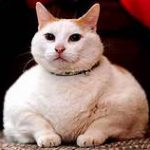
There is a difference. We are the ones who decide what our pet gets to eat. We put the food in front of him, so we are making the animal obese. Too many owners actually believe that the pet’s food intake has nothing at all to do with their pet’s weight.
If a cat appears overweight and you want to correct the problem, your first stop should be at your veterinarian’s. He needs to do a physical exam, measure the exact weight, and do blood and urine tests. It is also vital to do a thyroid hormone check to make sure levels are normal, and that there is no physical or metabolic dysfunction.
If the cat tests out normal, except for the extra pounds, then a weight-loss program can be put in place.
The main reason for feline obesity is eating too much food. If the cat has food available at all times, discontinue this practice. This “free choice” feeding has probably been the biggest single factor in causing obesity in cats.
In proportion to its size, a cat should eat about 1/25 of the amount a human eats. Feed between 0.6 to 1.0 ounce per meal for a seven-pound cat. That’s about the same size as a mouse. Stop thinking in terms of cups of food; instead, think in terms of ounces of food.
Carbohydrates
Cats, unlike us or our dog buddies, do not have amylase in their saliva. This is a carbohydrate digester that allows carbohydrates to begin digesting in the mouth. Cats do have amylase that is secreted in to the intestine, but it is a considerably smaller amount than in dogs or humans. Cats were not intended to consume carbohydrates.
We purchase dry food that can be poured into a bowl and forgotten. This dry food has more flour and sugar than canned foods. These ingredients are needed to keep the kibble from falling apart. Preservatives keep it from spoiling.
Unfortunately, in dry diets, this allows the high carbohydrate content to be converted into stored fat. Thus the cat is put at immediate risk of weight gain.
What Should Be Done
We need to feed a meat-based diet to our cat, consistent to his nature as a true carnivore. The ideal feline diet has a protein level in the 35 to 40% range once all water is removed, and contains moderate fat with a low percentage of grains, or carbohydrates.
These diets high in protein and fat are considered most beneficial to carnivores. Cats don’t handle large amounts of carbohydrates well. After eating a carbohydrate-rich meal, the cat’s blood level of glucose tends to stay higher for longer periods of time.
This long-term stimulus of the beta cells of the pancreas makes the cells less sensitive to the blood glucose. As these are the cells that produce insulin, due to this loss of sensitivity, less insulin is produced. This in turn produces a scenario that is a prelude to diabetes.
Protein
The need for protein is one reason your cat hunts for mice and birds. These are the perfect diet for a cat, as the mouse or the bird is only made up of three to eight percent carbohydrate. Mostly that is in the digestive tract, which the cat discards when he eats. The rest is water and a few minerals, but mostly protein and fat.
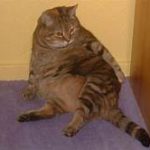
So we purchase the dry foods, complete with flour, sugar, and preservatives. After all, the bag says it is a complete and balanced meal. Unfortunately, most of the dry foods are quite low in protein. Less expensive brands will list grains such as corn as the first ingredient.
There is a myth that protein causes kidney problems. This is a totally untrue myth that has caused many cats and dogs to suffer from poor diets. We must feed a diet that is high in protein and low on carbohydrates (grains.)
If you expect the animal to remain at an optimum weight and maintain good health, you must feed him properly. Protein is the key nutrient needed in your cat’s diet.
If you use a dry weight basis (percent of ingredients without any water) the diet for your cat should be 35 to 45 percent protein, 40 percent fat, and perhaps just a small percent of carbohydrate. Remember that a carnivore needs no carbohydrates in their diet.
Cat Treats
We tend to award cats for good behavior with food, so treats have become popular. These treats are manufactured with an irresistible flavor for cats.
So, when the cat starts to meow and acts like it needs something, we often give him a treat.
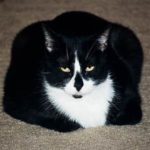
This is what I call the “opportunist cat” behavior. Once he finds a meow will bring a treat, he learns quickly, and meows even more in the hopes of more treats.
We need to stop feeding treats to that overweight cat. If you feel he really needs a treat, cut up some chicken or fish and feed him a natural protein treat, instead of one made from non-nutrients. Never feed as a way to stop meowing, because it will have just the opposite effect.
What Does The Label Say?
Very often, feeding the “recommended” daily amounts shown on the label will nearly always result in overfeeding. After all, the faster the cat eats that food, the sooner you will buy more. The odds are high that if you feed according to instructions on the bag, you will be giving more food than needed and the cat will end up overweight.
Therefore, adjust the amount fed to how much exercise your cat gets and how he looks. If he looks and feels overweight, he is. No matter what the package label says, you need to cut down the amount you are feeding.
Exercise
When we leave home for the day and fill all the food and water containers before we go, we are not adhering to the diet plan. We have to go to work, so how do we avoid this problem?
First of all, if your cat is an inside cat, he really doesn’t have much to do in the house all day except nap. There is nothing to stalk or chase. To give the cat some exercise, you need to have interactive play toys. For one solution, try one or two of these puzzle feeders, which make the cat work a bit for his food.
Perhaps you can add another cat to your family so the two can interact. Two cats are really not that much harder than caring for one cat, and they will have each other for company.
What To Feed Your Cat
Protein! Cats do not graze on plants; they hunt other animals. For them to be in optimum health, they must have protein. There are no vegetarian diets for cats.
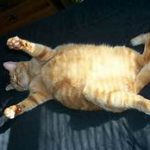
Since you are the cat’s caretaker, you have complete control over what he eats, how much he gets, and how often he is fed.
There are myths out there about too much protein being bad for dogs and cats, or that protein causes liver damage. Do some reading, as there are many documented reports that will update you on current research. These are myths — they are not true! Your animal needs lots of protein.
Weight Loss Diets
To get your cat to lose weight is a gradual process. Cats have a metabolic reaction to fasting that can result in a potentially fatal disorder called hepatic lipidosis. They cannot be put on a diet that rapidly reduces the amount of their meal.
A high protein diet is a success because it helps supply an amino acid called carnatene. This acid is found in good quantity in meat, especially muscle tissue, but is found in very small amounts in vegetables.
This amino acid plays a vital role in converting stored fats to glucose. The glucose is used for energy, and requires carnitine to do so.
You can supplement your cat’s diet with L-Carnitine in amounts of about 250 to 500 milligrams per day. This supplement will aid in mobilizing fat into glucose and will improve the cat’s health as well.
How To Put Your Cat On A Diet
First, have the vet do a thorough physical exam, which includes a blood chemistry profile and a thyroid hormone evaluation. Record the cat’s actual weight.
Then, gradually, over the course of three or four weeks, start adding the suggested weight-loss food to their regular meal, adding greater and greater proportions of the diet food over time. Mix the new with the old, slowly decreasing the old food as you add more and more of the new.
Pay close attention to how much your cat eats each day. Once the cat becomes used to the new diet, which should be fed in small amounts during the day, reweigh the cat at four-week intervals. If there is no weight loss at all, you are simply giving him too much food.
Think in cat-sized portions. Remember the mouse — the ideal weight for one meal. Weigh the cat every three to four weeks on the same scale. The loss should be gradual — a 15-pound cat should not lose more than a half pound in four weeks.
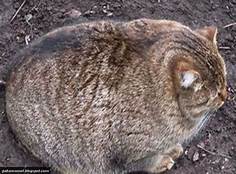
If your cat stops eating for two or more days, report to the vet. If a cat hasn’t eaten in three days, he is in trouble
Once you have a feeding plan that brings about gradual weight loss over a period of months, the cat will eventually reach an optimum point where weight maintenance comes about. At this point the cat should look neither fat nor thin, He will be much more active and alert.
You will have avoided the probability of the cat developing diabetes, arthritis, and hepatic lipidosis. The cat will probably live a few extra years and will have a much better quality of life.
The information for this post came from an excellent article on www.petmed.com. The article is titled Obesity in cats and how to put a cat on a diet.

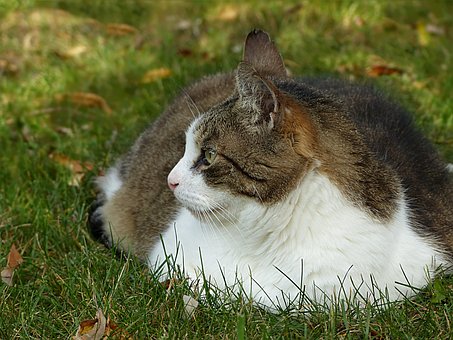
I usually love blogs about cats and actually appreciate your content. The article has genuinely peaks my interest. I’m going to bookmark your web page and maintain checking for new details. I am looking for some good blog sites for cat lovers. I was searching over search engines and found your blog site. Well i like your high quality blog site design plus your posting abilities. Keep doing it
Thank you very much for your comment. I am glad you liked my site, and am very pleased that you have bookmarked it. I hope to see you again.
Wow, this was a very informative article. We do neglect the fact that the cats metabolism really doesnt differ from our own.I also took note that the manufacturers recommendation being the proper amount of food to the cat.
It`s a disgrace that they put commercial interest over the cats health in order to sell more. Very interesting and insightful facts in this article that every cat owner (and pet owner in general) should be aware of.
Hello, and thank you for your comments. I think you may have misunderstood something. The manufacturer’s recommendation of how much to feed is often inaccurate. After all, he wants to sell more cat food, so he doesn’t care if he suggests a larger amount than necessary. You’d get more accurate information from your vet. Also, there is probably an online chart that suggests a size vs. quantity amount.
Yes, it is unfortunate that the business owner puts profit before proper health. Best to be aware of this.
There is quite a lot involved in caring for a cat isn’t there? And even though a fat cat might be funny to look at, there are underlying health issues that would be bad for the cat. I did not realise that cats are unable to digest carbohydrates easily and as a consequence, dry food would be a factor in weight gain for cats. Thanks for the informative article!
Thank you for your comments, Fiona.
It depends on the dry food. Some of them are full of carbs like cereal, and some are not. I fed my cat a dry food from Hill’s, because it was especially formulated for a cat with urinary tract issues. He loved that food, so glad I was able to find a dry food that he could eat.